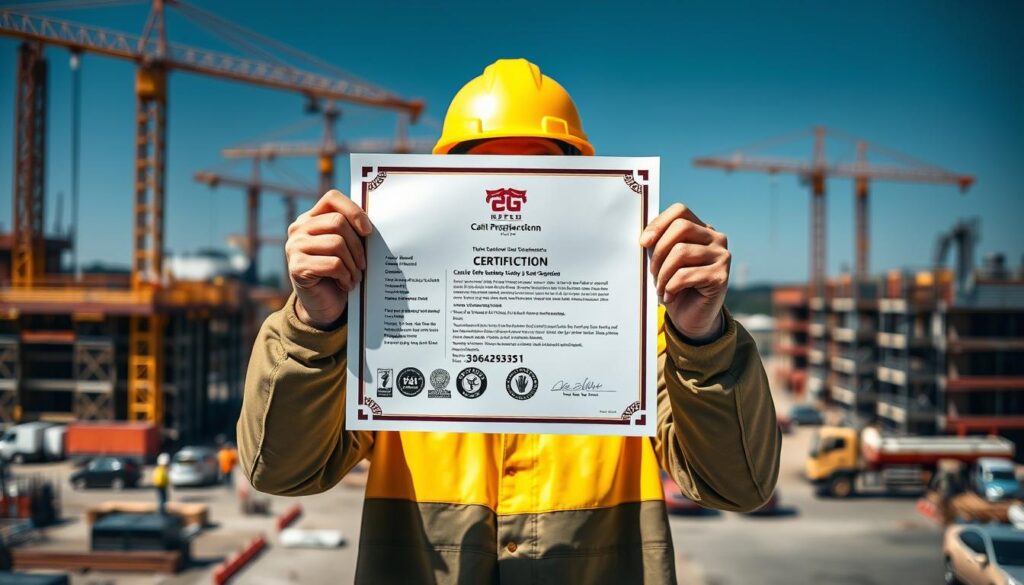Did you know 73% of construction firms plan to expand their supervisory teams by 2025? With infrastructure projects booming nationwide, leadership roles like foreman positions now demand dual expertise – technical know-how and team management skills. This shift creates opportunities for craft professionals ready to advance their careers.
Modern foremen act as project conductors, balancing safety protocols, crew coordination, and client communication. Employers now prioritize candidates who combine OSHA certifications with conflict resolution abilities. You’ll need at least 2-4 years of field experience plus proven leadership capabilities to compete.
Tools like RoboApply’s construction-specific resume templates help showcase these qualifications effectively. Their AI-powered builder optimizes applications for tracking systems while maintaining industry-specific formatting – critical when 82% of hiring managers use ATS software.
Key Takeaways
- Foreman roles now require leadership training alongside traditional technical skills
- Safety certification updates are mandatory for 2025 hiring standards
- ATS-optimized resumes increase interview chances by 60%
- Project management software literacy separates top candidates
- Networking accounts for 35% of supervisory role placements
Prepare for common foreman interview questions about crew motivation techniques and deadline management. RoboApply’s interview coach feature simulates real-world scenarios, helping you articulate solutions to complex worksite challenges.
Overview of the Construction Foreman Role
Modern construction sites rely on skilled professionals to coordinate complex operations seamlessly. This position requires balancing technical knowledge with leadership capabilities to maintain workflow efficiency and safety standards.
Key Responsibilities and Daily Duties
Your day starts with reviewing project blueprints and allocating resources. You’ll assign specific tasks to workers based on their expertise, ensuring proper equipment usage and adherence to timelines. Budget tracking becomes routine—monitor material costs and labor hours to prevent overspending.
Safety enforcement remains critical. Conduct morning briefings to reinforce OSHA guidelines and inspect personal protective gear. When conflicts arise between contractors or unexpected delays occur, you’ll implement solutions without halting progress.
Evolution From Craft Professional to Leader
Transitioning from hands-on work to supervisory management means developing new skills. Use your field experience to mentor junior team members while mastering scheduling software and quality control procedures.
Modern foremen now analyze real-time data from project management tools to optimize workflows. You’ll collaborate with architects and engineers more frequently, translating technical plans into actionable steps for your crew. This shift demands continuous learning about emerging construction technologies.
How to Land a Construction Foreman Job in 2025: Resume Strategies & Interview Insights
Foreman roles now offer 42% higher earnings than entry-level positions, with top performers earning performance bonuses up to $8,000 annually. To position yourself for these opportunities, start by reverse-engineering top employers’ needs through current job postings.

Scan platforms like ConstructionJobs.com for recurring requirements. Most listings demand 2-4 years of hands-on field experience plus leadership exposure. Highlight specific projects where you managed material logistics or resolved worksite conflicts.
Physical readiness remains non-negotiable. Employers verify candidates’ ability to lift heavy equipment and work 10-hour shifts in extreme temperatures. Update your resume with safety certifications like OSHA 30-hour training – 89% of 2025 postings list this as mandatory.
Bilingual skills create immediate advantages. One Texas contractor reported 35% faster project completion when supervisors spoke both English and Spanish. If you’re fluent, showcase this in your resume optimization strategies.
Geographic flexibility increases your candidacy strength. Many roles require regional travel or temporary site assignments. Demonstrate adaptability by mentioning multi-location projects in your work history.
Salary negotiations start with research. Foreman positions in commercial construction average $67,500 nationally, with union roles offering additional benefits. Use industry reports to benchmark your expectations during interviews.
Leveraging RoboApply Tools for a Winning Application
Construction leadership roles demand precision in every application detail. RoboApply’s suite streamlines the process while maintaining quality across multiple submissions.
Utilizing the AI Resume and Cover Letter Builder
Start with RoboApply’s AI Resume Builder. It scans thousands of foreman job descriptions to identify critical keywords like “crew scheduling” or “OSHA compliance.” The tool structures your experience using industry-approved formats that highlight leadership skills and technical expertise.
The Cover Letter Builder personalizes each submission. It extracts key requirements from job postings and aligns them with your project management achievements. This ensures hiring managers see your direct relevance to their open positions.
Maximizing ATS Optimization and Auto-Apply Features
Run every resume through the ATS Optimizer before submitting. This feature compares your document against the job description’s language patterns and suggests improvements. You’ll receive instant feedback on keyword density and formatting issues that could trigger rejections.
Save hours weekly with the Auto-Apply Chrome Extension. It populates application fields automatically while maintaining consistent messaging across platforms. Pair this with the Job Tracker to monitor responses and follow-up deadlines efficiently.
Strengthen industry connections using the Outreach CRM. Track conversations with potential references while preparing for interviews via simulated scenarios in the Interview Coach. These resume optimization strategies create a seamless path from application to offer.
Mastering Key Construction Skills and Certification Requirements
Construction leadership demands verified expertise. Your path to supervisory roles begins with targeted certifications and hands-on skill development. Employers prioritize candidates who combine technical knowledge with crew management abilities.

Getting Certified and Completing Safety Training
Start with OSHA’s 10-Hour Construction Safety Training. This program teaches hazard identification – falls, electrical risks, chemical exposure – and proper PPE protocols. You’ll learn emergency response tactics and legal compliance standards required for site access.
Advance your credentials through NASP certifications like Certified Safety Manager. These programs deepen your understanding of risk assessment and regulatory updates. Many firms reimburse tuition for approved courses, so check your employer’s educational assistance programs before enrolling.
Developing Leadership and Project Management Skills
The NCCER Construction Foreman Certification sharpens critical abilities. Their self-paced modules cover crew coordination, schedule optimization, and quality control processes. Apply these lessons daily by leading toolbox talks or resolving equipment disputes.
Master conflict resolution through role-playing common worksite scenarios. Practice delegating tasks while maintaining morale – essential skills when managing 15+ crew members. Combine this with CPR/first aid training to demonstrate comprehensive safety leadership.
Tailoring Your Resume for Each Application and ATS Success
Customizing your resume for each application isn’t optional—it’s your ticket past automated screening systems. Start by mirroring the job description’s exact phrases. If a posting requires “heavy equipment operation,” use those precise words rather than similar terms.
Keyword Integration and Transferable Skills
Highlight non-construction experience strategically. Warehouse roles become “material transport coordination” when applying for site management positions. Retail work transforms into “client-facing problem resolution” using industry-specific language.
Quantify achievements with concrete numbers. Instead of “managed teams,” write “supervised 8-12 workers on commercial projects exceeding $1.2M budgets.” List certifications like OSHA 30-Hour first—89% of hiring managers prioritize safety credentials.
Prioritize relevant experience regardless of chronology. If you led a roofing crew five years ago but recently worked in logistics, position construction leadership at the resume’s top. Include equipment proficiencies: “Operated telescopic forklifts for material placement” beats generic “machine experience.”
Use tools like machine operator resume examples to model effective formatting. These templates demonstrate how to showcase project scale and safety records while maintaining ATS-friendly structures.
Acing the Interview: Preparation, Soft Skills, and Professional Growth
Your interview performance determines whether years of field experience translate into career advancement. Focus preparation on three areas: technical expertise demonstration, leadership storytelling, and growth mindset communication.
Preparing for Behavioral and Technical Questions
Anticipate scenario-based queries about resolving worksite conflicts or adapting to weather delays. For technical questions, rehearse OSHA compliance steps for scaffolding setups or electrical safety protocols. Study common foreman interview questions about material waste reduction strategies.
Use specific project examples when answering. Instead of “I manage teams,” say: “Last spring, I realigned 12 workers across three zones to complete foundation work during unexpected concrete shortages.” Quantify outcomes like “cut downtime by 35%” to showcase problem-solving impact.
Showcasing Leadership and Communication Strengths
Highlight moments where you mentored junior members or improved crew efficiency. Describe how you conduct safety briefings using visual aids for multilingual teams. Share instances where you mediated subcontractor disputes without delaying project timelines.
Pair technical terms with soft skills: “Coordinated crane operations (technical) while maintaining crew morale during 14-hour shifts (leadership).” Update your resume using leadership-focused resume examples to mirror this balance before interviews.
End interviews by asking about professional development opportunities. This demonstrates commitment to growing as a leader while assessing the employer’s support for certifications like Advanced Safety Management.
FAQ
What’s the fastest way to transition from construction worker to foreman?
Focus on demonstrating leadership in your current role while completing certifications like OSHA 30-Hour. Document instances where you’ve managed small teams or solved on-site problems. Use tools like RoboApply’s resume builder to highlight these achievements with metrics like “Reduced material waste by 18% through improved inventory tracking.”
Which certifications are essential for foreman roles in 2025?
OSHA 30-Hour and First Aid/CPR remain critical. Employers increasingly value LEED Green Associate for sustainable projects and PMP for project management. State-specific licenses like California’s CSLB certification also strengthen applications. Pair these with NCCER credentials for specialized trades.
How do I make my resume stand out for foreman positions?
Use ATS optimization strategies by mirroring keywords from job postings like “safety protocols” or “subcontractor coordination.” Include quantifiable wins: “Cut project delays by 22% via revised scheduling.” RoboApply’s AI analyzer ensures your resume meets hiring algorithms’ requirements while maintaining readability.
What interview questions should I prepare for?
Expect behavioral questions like “Describe resolving a safety violation” and technical scenarios such as “How would you handle delayed material deliveries?” Practice using the STAR method (Situation, Task, Action, Result) to structure responses. Highlight conflict resolution examples, like mediating crew disputes.
Can RoboApply help if I lack direct foreman experience?
Yes. Its transferable skills detector identifies relevant leadership moments from non-managerial roles, like training new hires or optimizing equipment workflows. The cover letter generator reframes these into foreman-ready narratives, emphasizing OSHA compliance or budget management.
What soft skills are most valued for foreman roles?
Communication tops employer lists—prove you can translate blueprints to crews and updates to stakeholders. Adaptability is critical for handling weather delays or design changes. Showcase conflict resolution through examples like resolving subcontractor disputes without project delays.
How important are technology skills for modern foremen?
Proficiency in construction software like Procore or Bluebeam is now expected. Highlight experience with drone site surveys, BIM tools, or automated reporting systems. RoboApply’s job-specific keyword scanner ensures these tech terms align with each employer’s tools.
What’s the career growth path after becoming a foreman?
Many advance to project manager or superintendent roles within 3-5 years. Pursue certifications like CM-Lean or Certified Construction Manager (CCM). Document leadership on complex projects—high-rise builds or infrastructure upgrades—to qualify for senior positions.


















